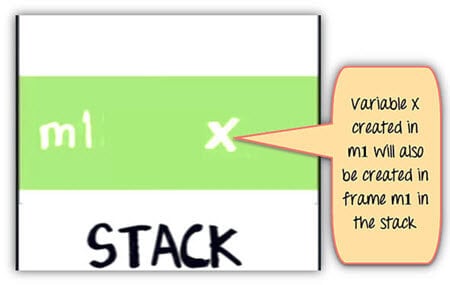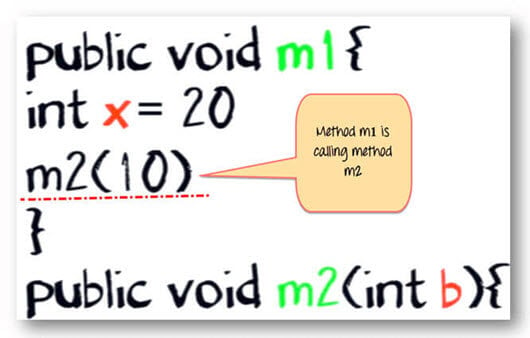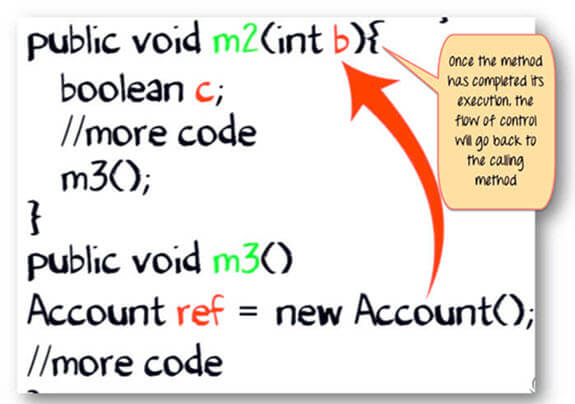Memory Management in Java
What is Stack Memory?
Stack in java is a section of memory which contains methods, local variables, and reference variables. Stack memory is always referenced in Last-In-First-Out order. Local variables are created in the stack.
What is Heap Memory?
Heap is a section of memory which contains Objects and may also contain reference variables. Instance variables are created in the heap.
Memory Allocation in Java
Memory Allocation in Java is the process in which the virtual memory sections are set aside in a program for storing the variables and instances of structures and classes. However, the memory isn’t allocated to an object at declaration but only a reference is created. For the memory allocation of the object, new() method is used, so the object is always allocated memory on the heap.
The Java Memory Allocation is divided into following sections :
- Heap
- Stack
- Code
- Static
This division of memory is required for its effective management.
- The code section contains your bytecode.
- The Stack section of memory contains methods, local variables, and reference variables.
- The Heap section contains Objects (may also contain reference variables).
- The Static section contains Static data/methods.
Difference between Local and Instance Variable
Instance variable is declared inside a class but not inside a method
class Student{
int num; // num is instance variable
public void showData{}
Local variable are declared inside a method including method arguments.
public void sum(int a){
int x = int a + 3;
// a , x are local variables;
}
Difference between Stack and Heap
Click here if the video is not accessible
Let’s take an example to understand this better. Consider that your main method calling method m1
public void m1{
int x=20
}
In the stack java, a frame will be created from method m1.
The variable X in m1 will also be created in the frame for m1 in the stack. (See image below).
Method m1 is calling method m2. In the stack java, a new frame is created for m2 on top of the frame m1.
Variable b and c will also be created in a frame m2 in a stack.
public void m2(int b){
boolean c;
}
Same method m2 is calling method m3. Again a frame m3 is created on the top of the stack (see image below).
Now let say our method m3 is creating an object for class “Account,” which has two instances variable int p and int q.
Account {
Int p;
Int q;
}
Here is the code for method m3
public void m3(){
Account ref = new Account();
// more code
}
The statement new Account() will create an object of account in heap.
The reference variable “ref” will be created in a stack java.
The assignment “=” operator will make a reference variable to point to the object in the Heap.
Once the method has completed its execution. The flow of control will go back to the calling method. Which in this case is method m2.
The stack from method m3 will be flushed out.
Since the reference variable will no longer be pointing to the object in the heap, it would be eligible for garbage collection.
Once method m2 has completed its execution. It will be popped out of the stack, and all its variable will be flushed and no longer be available for use.
Likewise for method m1.
Eventually, the flow of control will return to the start point of the program. Which usually, is the “main” method.
What if Object has a reference as its instance variable?
public static void main(String args[]) {
A parent = new A(); //more code } class A{ B child = new B(); int e; //more code } class B{ int c; int d; //more code }
In this case , the reference variable “child” will be created in heap ,which in turn will be pointing to its object, something like the diagram shown below.
What is Garbage Collection in Java?
Garbage Collection in Java is a process by which the programs perform memory management automatically. The Garbage Collector(GC) finds the unused objects and deletes them to reclaim the memory. In Java, dynamic memory allocation of objects is achieved using the new operator that uses some memory and the memory remains allocated until there are references for the use of the object.
When there are no references to an object, it is assumed to be no longer needed, and the memory, occupied by the object can be reclaimed. There is no explicit need to destroy an object as Java handles the de-allocation automatically.
The technique that accomplishes this is known as Garbage Collection. Programs that do not de-allocate memory can eventually crash when there is no memory left in the system to allocate. These programs are said to have memory leaks. Garbage collection in Java happens automatically during the lifetime of the program, eliminating the need to de-allocate memory and thereby avoiding memory leaks.
In C language, it is the programmer’s responsibility to de-allocate memory allocated dynamically using free() function. This is where Java memory management leads.
Note: All objects are created in Heap Section of memory. More on this in a later tutorial.
Example: To Learn Garbage Collector Mechanism in Java
Step 1) Copy the following code into an editor.
class Student{
int a;
int b;
public void setData(int c,int d){
a=c;
b=d;
}
public void showData(){
System.out.println("Value of a = "+a);
System.out.println("Value of b = "+b);
}
public static void main(String args[]){
Student s1 = new Student();
Student s2 = new Student();
s1.setData(1,2);
s2.setData(3,4);
s1.showData();
s2.showData();
//Student s3;
//s3=s2;
//s3.showData();
//s2=null;
//s3.showData();
//s3=null;
//s3.showData();
}
}
Step 2) Save, Compile and Run the code. As shown in the diagram, two objects and two reference variables are created.
Step 3) Uncomment line # 20,21,22. Save, compile & run the code.
Step 4) As shown in the diagram below, two reference variables are pointing to the same object.
Step 5) Uncomment line # 23 & 24. Compile, Save & Run the code
Step 6) As show in diagram below, s2 becomes null, but s3 is still pointing to the object and is not eligible for java garbage collection.
Step 7) Uncomment line # 25 & 26. Save, Compile & Run the Code
Step 8) At this point there are no references pointing to the object and becomes eligible for garbage collection. It will be removed from memory, and there is no way of retrieving it back.
How to delete an object in Java?
1) If you want to make your object eligible for Garbage Collection, assign its reference variable to null.
2) Primitive types are not objects. They cannot be assigned null.
Summary:
- When a method is called, a frame is created on the top of the stack.
- Once a method has completed execution, the flow of control returns to the calling method and its corresponding stack frame is flushed.
- Local variables are created in the stack
- Instance variables are created in the heap & are part of the object they belong to.
- Reference variables are created in the stack.



















